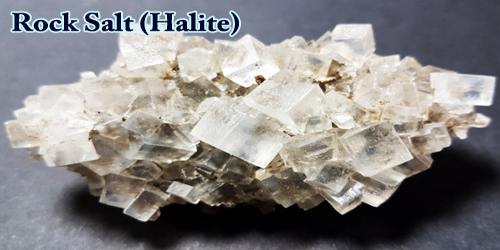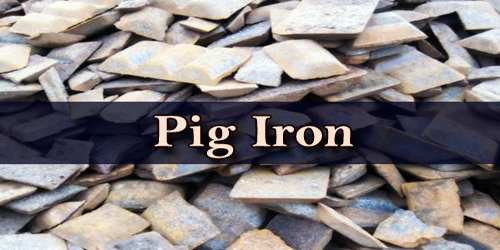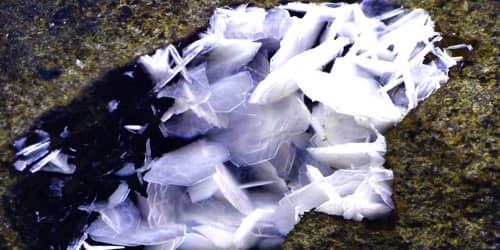Rock Salt, also known as Halite (/ˈhælaɪt/ or /ˈheɪlaɪt/) is the least processed form of salt. It is a type of salt, the mineral (natural) form of sodium chloride (Na Cl). It is salt that’s taken directly from a salt mine; directly from the underground mineral deposit. Rock salt is used just in the form is found underground. The only processing done to it is that we crush it and screen it to get a size range of crystals that’s convenient to put down on the road. Because of this, it’s also the lowest cost form of salt, and therefore, it’s what’s most commonly used in deicing.
Halite forms isometric crystals. The mineral is typically colorless or white, but may also be light blue, dark blue, purple, pink, red, orange, yellow or gray depending on inclusion of other materials, impurities, and structural or isotopic abnormalities in the crystals. It commonly occurs with other evaporite deposit minerals such as several of the sulfates, halides, and borates. The name halite is derived from the Ancient Greek word for salt, ἅλς (háls).
The world’s largest underground salt mine is the Sifto Salt Mine. It produces over 7 million tons of rock salt per year using the room and pillar mining method. It is located half a kilometre under Lake Huron in Ontario, Canada. In the United Kingdom there are three mines; the largest of these is at Winsford in Cheshire, producing, on average, one million tonnes of salt per year.

Occurrence –
Rock Salt or Halite occurs on all continents in beds that range from a few meters to more than 300 m (1,000 feet) in thickness. Termed evaporite deposits because they formed by the evaporation of saline water in partially enclosed basins, they characteristically are associated with beds of limestone, dolomite, and shale. Halite also occurs as a sublimation product in volcanic regions, efflorescence in arid regions, and an evaporation product near salt springs. Deformation of halite beds sometimes results in the extrusion of plugs of salt through overlying sediment, as in salt domes and diapirs. Halite is found in large deposits in southeastern Russia; Dax, Fr.; Punjab, India; Ontario, Canada; and New York, Texas, and Louisiana, U.S.
In the United States and Canada extensive underground beds extend from the Appalachian basin of western New York through parts of Ontario and under much of the Michigan Basin. Other deposits are in Ohio, Kansas, New Mexico, Nova Scotia and Saskatchewan. The Khewra salt mine is a massive deposit of halite near Islamabad, Pakistan.
Unusual, purple, fibrous vein filling halite is found in France and a few other localities. Halite crystals termed hopper crystals appear to be “skeletons” of the typical cubes, with the edges present and stairstep depressions on, or rather in, each crystal face. In a rapidly crystallizing environment, the edges of the cubes simply grow faster than the centers. Halite crystals form very quickly in some rapidly evaporating lakes resulting in modern artifacts with a coating or encrustation of halite crystals. Halite flowers are rare stalactites of curling fibers of halite that are found in certain arid caves of Australia’s Nullarbor Plain. Halite stalactites and encrustations are also reported in the Quincy native copper mine of Hancock, Michigan.
Uses –
Rock Salt has many uses. Most of the salt produced is crushed and used in the winter on roads to control the accumulation of snow and ice. Significant amounts of salt are also used by the chemical industry. Salt is an essential nutrient for humans and most animals, and it is also a favorite seasoning for many types of food. Salt is a mineral that everyone knows.
Salt is used extensively in cooking as a flavor enhancer, and to cure a wide variety of foods such as bacon and fish. It is frequently used in food preservation methods across various cultures. Larger pieces can be ground in a salt mill or dusted over food from a shaker as finishing salt. Halite is also often used both residentially and municipally for managing ice.
In addition to de-icing, rock salt is occasionally used in agriculture. An example of this would be inducing salt stress to suppress the growth of annual meadow grass in turf production. Other examples involve exposing weeds to saltwater to dehydrate and kill them preventing them from affecting other plants. Salt is also used as a household cleaning product. Its coarse nature allows for its use in various cleaning scenarios including grease/oil removal, stain removal, and even dries out and hardens sticky spills for an easier clean.
Information Sources:
















